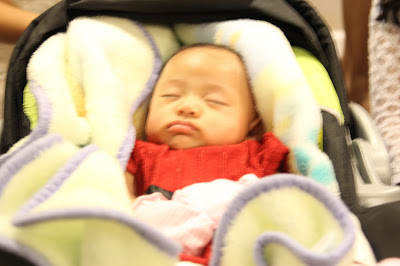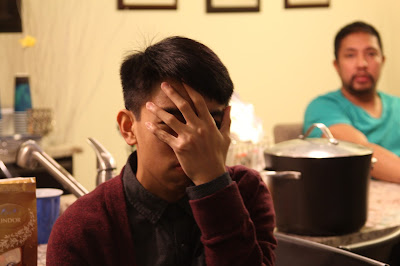In this chapter I learned that "A good exposure involves balancing the aperture, shutter speed and ISO." (Gatcum 45). Shutter speed is shown as a fraction and the higher the shutter speed, the less blurry the photo will be. Aperture is measured like a fraction, but looks like f/2.8 or f/32. I learned that the lower the number of the aperture setting, the more isolated [or focused] the image will be. Finally, ISO is the light sensitivity and also is what causes graininess in a photo; the higher the ISO, the brighter the photo will be. It will also be much more grainy than a photo with a lower ISO setting.
I found it so much easier to take photos during Christmas and Christmas Eve due to the fact that my family believes it is the best time to take photos. During this holiday, everyone is dressed nicely [or in ugly Christmas sweaters] and it made it so much easier to do my job as the family photographer.
The first concept I focused on was the shutter speed [also referred to as "exposure"]. I personally found it difficult to alter this setting because in order for the shutter speed to turn out well, you also must balance the aperture along with it. From experience in the past, I found that if one of the settings is too high or too low, then the photo won't turn out the way you wanted it to be. The author states "There's no reason why you shouldn't take several shots using different shutter speeds, increasing the amount of movement blur as you go, so you have a number of options to choose from." (Gatcum 69).
Here is an example of me changing my shutter speed:
 |
| Aperture: f/4 Exposure: 1/4 sec. ISO speed: ISO-800 |
 |
| Aperture: f/4 Exposure: 1/8 sec. ISO speed: 800 |
The next concept of exposure that I focused on was the aperture [also known as the depth of field]. The author states, "When you increase the size of the aperture, or open up the lens, you allow more light to reach the sensor. This reduces depth of field, so less of the scene appears in focus..." (Gatcum 46). This means that if the aperture is f/2.8 [for example], then the subject is more isolated or focused on than an aperture of f/16.
In the following photos I worked on the aperture:
 |
| Aperture: f/4 Exposure: 1/20 sec. ISO: 1600 |
 |
| Aperture: f/4 Exposure: 1/15 sec. ISO: 1600 |
The last concept was ISO. I believe that this was the easiest because once you balanced the shutter speed and aperture, you just had to decide on the brightness/darkness of the photo. Chris Gatcum says, "The ISO setting controls how sensitive your sensor is to light: low ISO settings indicate low sensitivity, while high ISO settings equate to high sensitivity." (Gatcum 46). The ISO setting also determines whether a photo will be more grainy or not [the higher the ISO, the more grainy the photo will be] and the detail of the photo [the lower the ISO setting, the more detailed the photo will be].
The following photos is where I focused on ISO:
 |
| Aperture: f/6.3 Exposure: 1/30 sec. ISO: 1600 |
 |
| Aperture: f/4 Exposure: 1/15 sec. ISO: 800 |
Overall, I felt as if the aperture and shutter speed was the hardest to set due to the balance between the two settings. What do you guys think is the hardest concept to master when dealing with exposure and why? Let me know in the comments below!
No comments:
Post a Comment